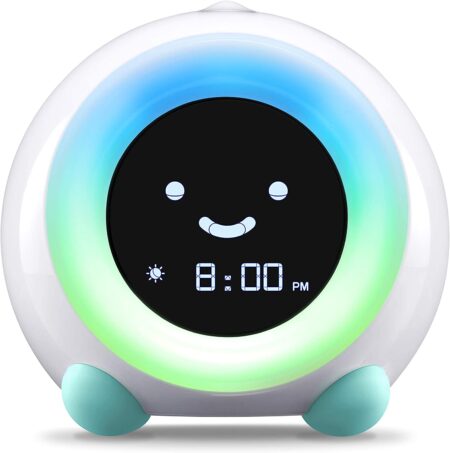Raise your hand if you’ve been victimized by a child standing over your bed like a Victorian ghost at 4:30 am, waking you from a sound sleep and shaving at least six months off your life. 🙋♀️ The sun may not be up, but they certainly are and now you are too.
Welcome to the second installment of sleep training, mama! With babyhood and the security of a crib in the rearview, now’s the time to teach your toddler when it’s time to stay in bed and when it’s OK to get the party started. And since numbers on a clock mean nothing at this age, an OK to wake clock is the way to go.
Motherly Digital Classes
•
$15
Helping your baby sleep better is like introducing any new skill. It takes time, consistency, and flexibility. In this class, Rachel outlines the key developmental changes you can expect and how to work with these changes for better sleep
What is an OK to wake clock?
OK to wake clocks (also called sleep training clocks or toddler alarm clocks) use visual cues instead of numbers to let kids know if it’s time for sleeping or OK to get up–even before they’re old enough to tell time. The best versions also double as sound machines and night lights, creating a calming bedtime routine and kid-friendly sleep environment. And we can’t make any promises, but in our own personal experiences, they also help the entire house get more sleep.
At what age can you use an OK to wake clock?
If your little one is old enough to understand the concept, they’re old enough! Generally between the ages of two and three kids are old enough to understand that red means stay in bed, green means it’s OK to get up. The good news is, many styles are designed to last long after they can tell time.
How to introduce an OK to wake clock
Don’t expect a kiddo who’s currently waking with the birds to suddenly sleep until 9. (Though that would be rather blissful, wouldn’t it?) Instead, opt for a more realistic expectation and go from there. If they’re currently launching themselves into your bed at 6 am, set their clock for 6:30. Make it as easy as possible for them to be successful and then celebrate their wins. Eventually, they’ll fall into a wake up routine that’s as dependable as their bedtime.
Do OK to wake clocks work?
With a bit of practice, parents and experts alike agree that sleep training clocks are an effective tool to help kids develop healthy sleep habits. As with so many situations, toddlers thrive on routine and clear expectations. Think about your typical preschool classroom. Everything from their daily schedule to where to line up is clearly defined with pictures and labels. An OK to wake clock makes time a visual concept with rules they can understand and follow. They’re also a big help during daylight saving time. After all, just because the clocks change, it doesn’t mean their tiny biological clock shifts with it.
While there is an ever-growing collection of OK to wake clocks out there, we’ve done the research to find the ones worth buying. From simple models that cover the basics to versatile app-enabled versions with all the bells and whistles, these are best OK to wake clocks based on our personal experience and rave reviews from friends and parents.
Best OK to wake clocks for toddlers and preschoolers
Hatch
•
$69.99
You could call it an all-in-one sleep training tool but we prefer to just call it magic. From the quality and design to the impressive list of features, the Hatch Rest 2nd Generation is our all-around top pick for a whole host of reasons. For one thing, it checks the box of a clock, sound machine and nightlight, which keeps nightstand and dresser clutter to a minimum. But more importantly, it performs all those tasks like a champ. Pair it with the Hatch app to program sleep and wake times with sounds and colors, accompany their slumber with a wide selection of white and pink noise options and even check in with them via the audio monitor. The range of volume and brightness along with the quality of sound is *chef’s kiss* and since it operates via wifi, you can adjust everything without ever even stepping foot in their room. This latest launch is a more robust version of the best-selling Rest+, offering a brand new library of expert developed content to help create healthy sleep habits. There are calming meditation routines, peaceful dreamscapes and stories crafted for winding down. While it does require a subscription to get access to that content ($49.99/year or $4.99/month), it’s not required for the rest of the features to work!
LittleHippo
•
$49.99
Created by actual parents, the LittleHippo Mella clock is as adorable as it is functional. The cute but not cluttered design is perfect for kiddos who don’t yet grasp the concept of time, waking you up at the most ungodly of hours. (Just because the birds are up, it doesn’t mean you want to be!) Based on the times you set, the face glows red, yellow and green to know whether it’s time for sleep, quiet play or time to wake up. The display also features a face that changes from sleepy to awake as the time progresses and a digital clock, ensuring it will last well beyond the toddler years. Throughout the night, it can act as a nightlight (with six colors to choose from) and sound machine with three calming sleep sounds. When it’s time to wake up, three kid-friendly sounds can start the day.
Tommee Tippee
•
$33
Another option for little ones who are still learning the concept of time, the Tommee Tippee Groclock uses pictures and colors to let them know when it’s time to get up or stay in bed. Instead of just switching from blue to orange to indicate that it’s OK to wake, the stars begin to fade one by one. Once they’re gone, the owl’s eyes open and only the hearts remain! The Groclock allows parents to set two different wake up times for naps or weekends and accompany with sound or not. There’s also an optional digital clock display for when they’re old enough to tell time. And don’t worry about it being too bright! The screen is totally adjustable and can even be turned off completely.
PlayMonster
•
$54.99
Analog(ish) parents rejoice! If you want to teach your child to read the hands of a clock while they also learn when it’s acceptable to demand breakfast, PlayMonster checks all the boxes. Similar to other OK to wake clocks, it uses color to help them know when it’s OK to get out of bed (yellow when it’s not, green when it is) with an optional sound alarm when it’s time to wake up. But what makes it special is the educational aspect. Along with the digital time, it also shows a clock face that lets them practice reading the analog way. There’s even a time teaching game with five adjustable skill levels to test their knowledge. The only drawbacks are that you can’t set different times for weekends and weekdays as well as the fact the backlit display can’t be turned off. If your child prefers total darkness, this may not be the best option!
Windflyer
•
$42.99
We love the multi-layered features of the Windflyer OK to Wake Clock which help kids of all ages learn when it’s OK to get out of bed. Along with a ring that changes from red to green, this cute little clock trains kids with its facial expressions. Throughout the night, the dimmable ring can serve as a night light that can be programmed to glow five different colors and optional sleep sounds can play for short periods or continuously. Fighting a nap time battle as well? No problem. When it’s time for them to go down or just have some quiet time in their room, you can manually activate a 15/30/60/90/180 minute timer that shows a sleepy face right away. Wake up sounds are optional and easy to program–well, for you anyway. A child lock on the bottom panel keeps curious kiddos from going totally ham on the buttons and throwing everything into chaos. (Sound familiar?) Reviewers also note that they like the option to turn off the “play” mode that comes between sleep and wake times. Sometimes, it’s simply time to get up!






